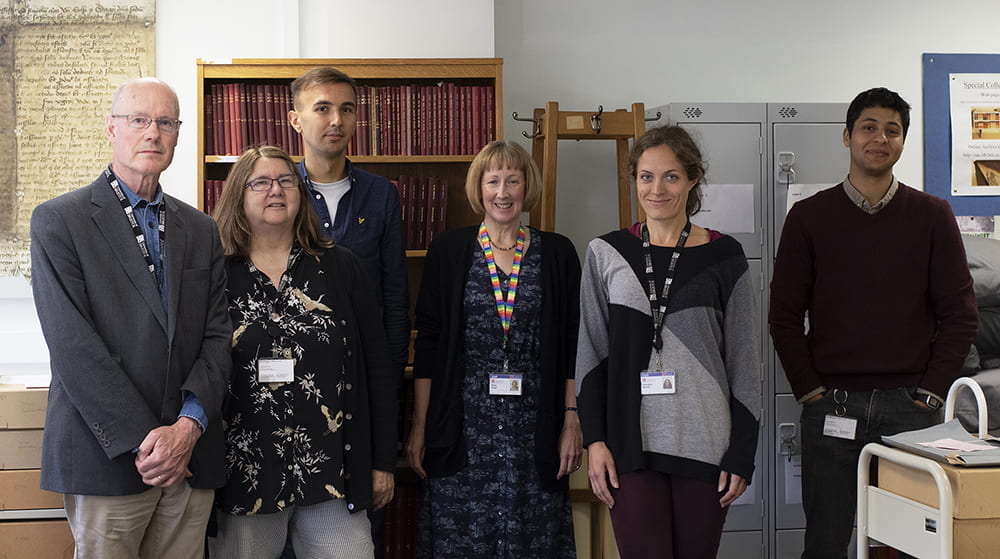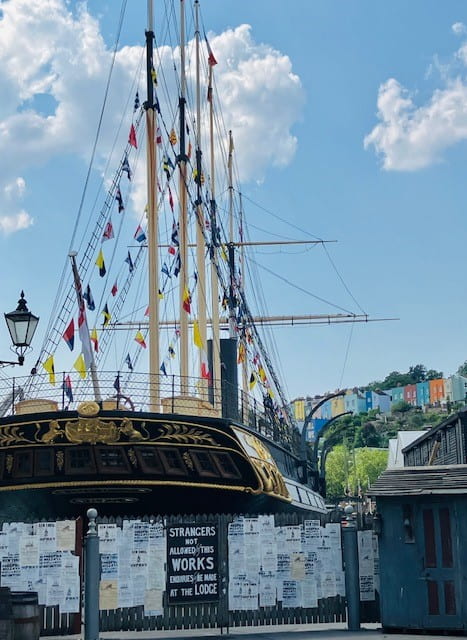Hannah Lowery, Archivist and Special Collections Manager, has penned this guide to Special Collections resources available online.
Special Collections holds over 5km of books, archives, photographs, and artefacts dating from the eleventh to the twenty-first century. Due to the current Covid-19 situation you can’t visit us, but here is a brief guide to viewing some of our holdings remotely.
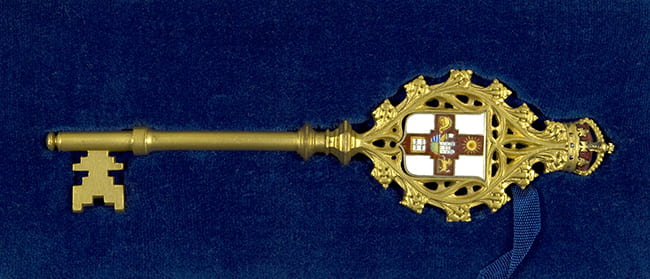
Ceremonial key used by King George V to open the Wills Memorial Building on 9th June 1925. DM320.
Start with our web pages.
Use our guide to ‘collection strengths‘ to find out more.
Use the library catalogue to find out about our book holdings, though you will often have to use other sources to find physical or electronic copies of the books.
Our colleagues are bringing together lists of resources available online, so go to the Library page to find them. Some may only be for University of Bristol people, but there is a wide variety of materials available for all.
Remember if you need advice, or want to find out more, do email us at special-collections@bristol.ac.uk and we will try and help.
Sit down for a tour of our Online Archive Catalogue, and a guide as to where you might find digitised materials, which you can investigate.
Note that when you click on a ‘thumbnail’ image at the bottom of a record in the Online Archive Catalogue, you can view a larger version. For even closer study, click on the symbol for a magnifying glass at the top right. Any text should be fully readable. To close the enlarged image, click on the ‘x’ at the top right.
University of Bristol materials
We hold the ever growing archive of University College Bristol (1876-1909) and the University of Bristol (1909 to date). As well as papers of academics, departments and students you can find out about the buildings and much more.
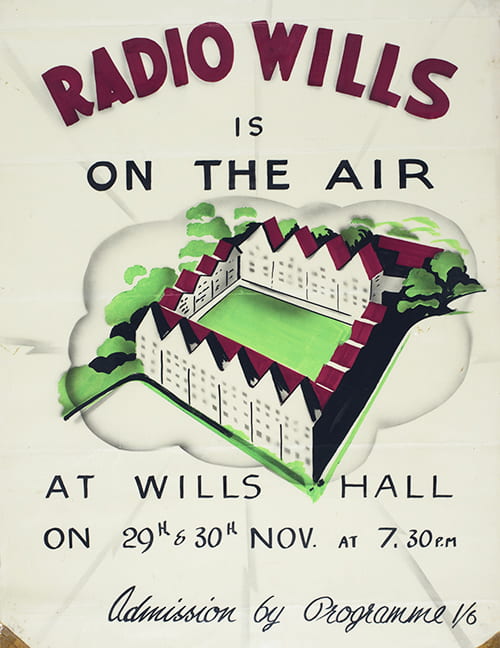
Poster about Radio Wills. DM1447/2.
Did you know that Winston Spencer Churchill (1874-1965) was Chancellor of the University from 1929 until his death? A search in the online archive catalogue brings up 226 mentions of archives relating to Churchill.
For instance, DM270 contains digitised photograph albums relating to visits to Bristol by Churchill in 1951 and 1958. Click here to find a photograph of Ralph Vaughan Williams (1872-1958) being granted an honorary degree by Churchill on 14 December 1951.
DM1310 is the archive of Sir Charles Frank (1911-1998), who was a physicist.
Although the entire catalogue is not yet available on line, there is a PDF, of the catalogue. We hope to spend the coming months working on making these lists more available.
There are extensive archives relating to the University of Bristol Physics Department, including the papers of Noble Prize winner Cecil Powell (1903-1969) – for example DM517.
Isambard Kingdom Brunel (1806-1859)
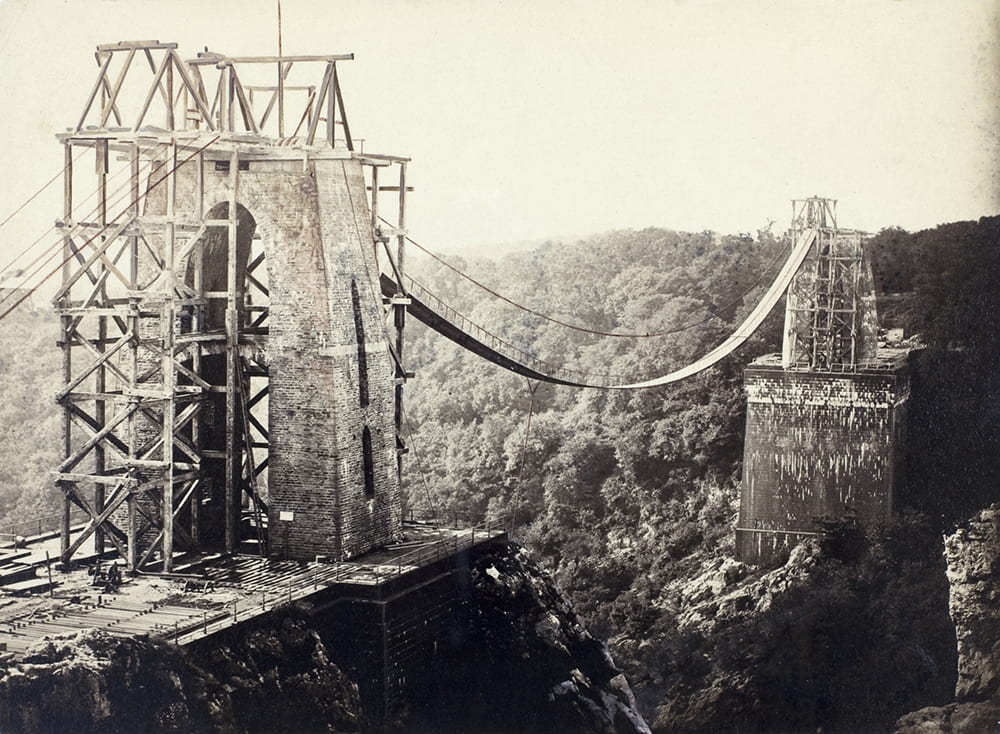
A view of Clifton Suspension Bridge, Bristol, from St Vincent’s Rocks, showing the piers under construction, along with chains, and scaffolding on the towers. DM216/3/4.
Interested in Victorian Engineering and the extended Brunel family? You are in luck! Our extensive archive relating to Brunel and his family is held at the Brunel Institute, a collaboration between the SS Great Britain and the University of Bristol.
Our online archive catalogue is where you can find descriptions of the archives and related images. Explore Brunel’s letters, letterbooks, sketchbooks, competition drawings for the Clifton Suspension Bridge, and more.
For instance, do a search for DM162, which was the first gift from the Brunel family to University of Bristol Special Collections…
DM162/10: Letterbooks.
DM162/10/1: Letter book covering 27 May 1832-5 November 1839.
Isambard Kingdom Brunel to W L Moorsom, 9 April 1836, concerning the Cheltenham Railway.
DM162/8: Isambard Kingdom Brunel Sketchbooks and Calculation Books. There are 63 of these, covering the period 1829-1859. Click on the link above and you can see sketchbooks arranged by size or topic (Small, Large, Great Western, Other).
A personal favourite of mine is in Great Western Sketchbook 10 – something we might not expect to see in an engineering related sketchbook.
We will return to Brunel in the future, but you can now view newly uploaded materials on the Great Eastern and more (See a previous blog by our colleague Emma Howgill about the Great Eastern ship).
The current change to how we work presents an opportunity to get more paper catalogue lists online, which will make them more accessible in the future.
Medieval Manuscripts
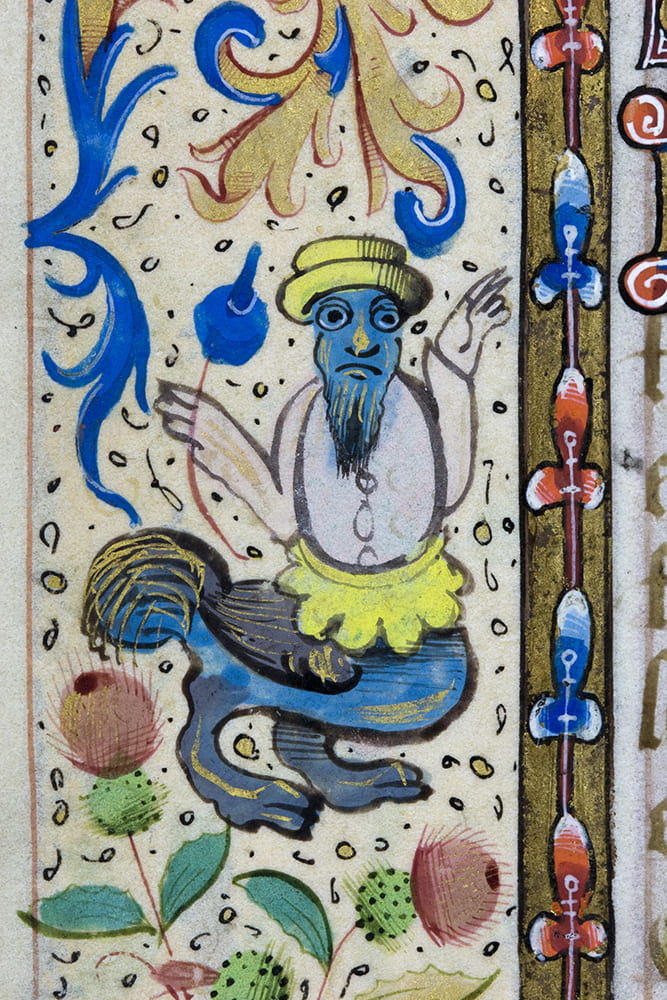
A grotesque or drollery, perhaps serving as a mnemonic, in the margin of a folio in the Cobden Book of Hours. DM832.
There are sixteen examples of medieval manuscripts if you search under the ‘Major Collections’ tab for medieval manuscripts in the advanced search, including:
DM104 Kingswood Abbey Deeds, Gloucestershire
The deeds cover the period 1225-1444, and include grants of land to the abbey, confirmation of grants, accounts of receipt and expenditure, confirmations of privileges, and papal letters. They are reputed to contain the oldest surviving rent rolls in England.
Go to the catalogue to find out more about the Abbey which was founded by William of Berkeley in 1139. The fifty deeds have been digitised. For instance here is a link to DM104/1 which is a grant of lands in Culkerton, Gloucestershire in 1225.
Two academics from British Universities have approached us about these recently, so it is nice to be able to share all of the images with everyone.
You might also want to explore DM832 Cobden Book of Hours
This is an early 15th-century Book of Hours designed for use in the diocese of Troyes, France and made on parchment, the text in French and Latin. Watch Dr Erica O’Brien (Department of History of Art, University of Bristol) talk about its beauty and significance, currently understudied. It is beautifully illustrated, and this bird recently got people talking, what do you think it is? (See our twitter feed for earlier discussion of a part of ff74r-77r Penitential Psalms – an image of this folio is at top of the thumbnails shown here)
DM58 Pinney Papers
We hold on deposit for the Pinney family extensive archives relating to their family, including their estates in Britain and the West Indies. If you are Bristol based, you may know that the Georgian House Museum on Great George Street, now in the possession of Bristol Museums, was once owned by the Pinney family.
Digital images of only one item from DM58 are presently available online, which is DM58/6/Pinney Miscellaneous 7. This is a notebook covering the period 1783-1794, and includes instructions from the Pinney family to Joseph Gill their land manager, on how to manage their estate. You can read each page separately.
We hope to do more work on this, so return if you want to find out more.
DM1031 Humphry Repton’s Red Book for Leigh Court, Abbots Leigh
Humphrey Repton (1752-1818) designed new grounds for the Miles family for their property at Leigh Court, Abbots Leigh, near Bristol, in 1814.
You can explore the drawings via the link above. This book was loaned to the Garden Museum in London in 2018, with many other Red Books to mark the bicentenary of Repton’s death.
John Addington Symonds
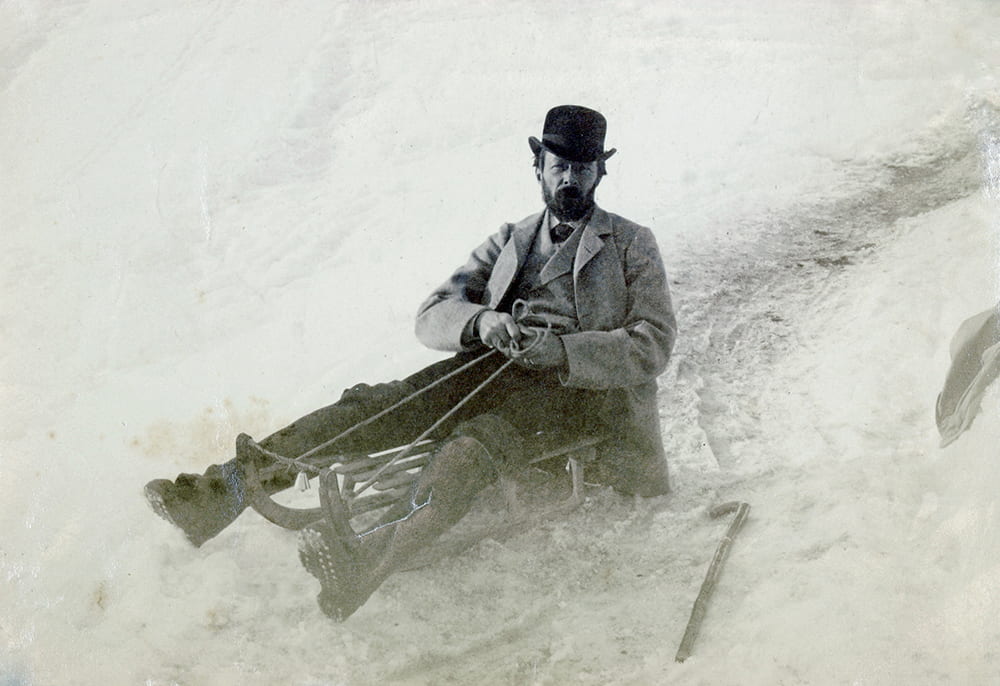
John Addington Symonds on a toboggan, Davos, Switzerland. DM377.
John Addington Symonds, (1840-1893), lived at Clifton Hill House, Bristol, now one of the University of Bristol Halls of Residence. He wrote on the Italian Renaissance, and had a talented and extended family, which included his daughters Madge Vaughan (1869-1925) and Dame Katharine Furse (1875-1952).
We may return to them in the future, but for the moment take time to look at the family scrapbook (DM375/1), compiled by Madge Vaughan and her daughter Janet. Here you can explore photographs of family life in Bristol and Davos, Switzerland, where John Addington Symonds was forced to live due to health issues. Find photographs of family groups tobogganing, of friends such as Robert Louis Stephenson (a portrait by Albert George Dew Smith), as well as artwork of flowers and alpine gardens, well-loved family dogs, and press cuttings.
We hope that this helps as a starter to the wealth of Special Collections materials available to all, and do return to find out more. And remember to ask if you have any questions, and we will help if we can (email us at special-collections@bristol.ac.uk).
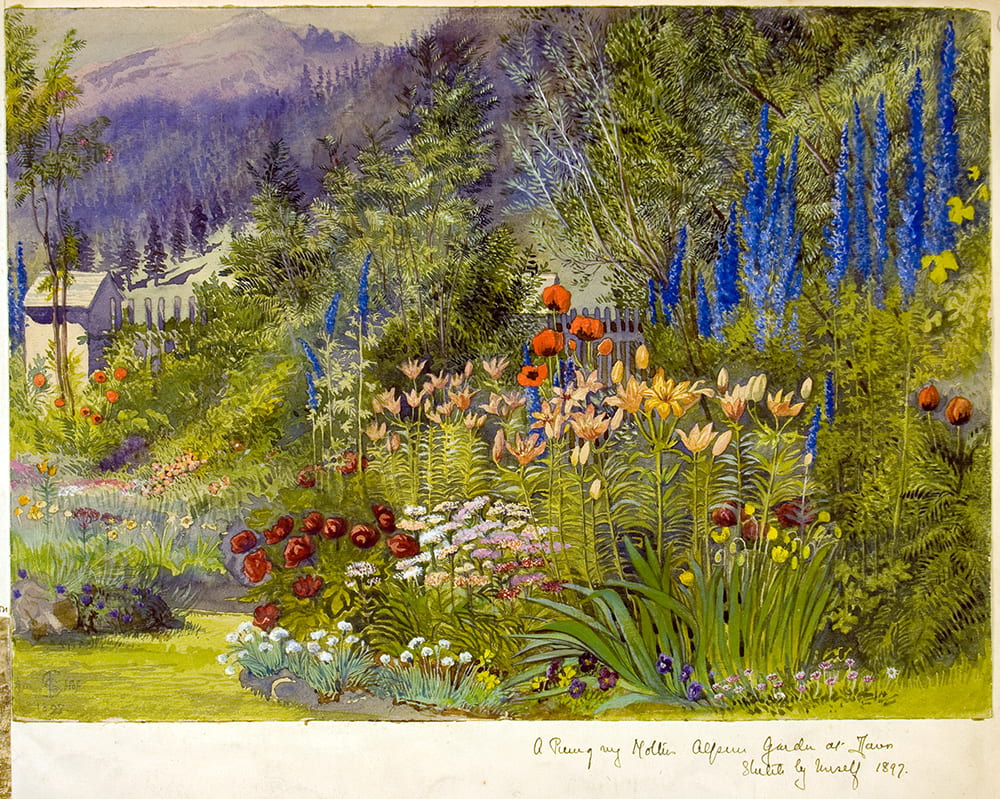
Spring is coming! Artwork by Margaret Symonds (Madge Vaughan) of the garden at ‘Am Hof’, Davos Platz, Switzerland, entitled ‘A View of my Mother’s Alpine Garden at Davos / Sketch by Myself 1897’. DM375/1.
